#kata-tjuta
Explore tagged Tumblr posts
Video
0 notes
Text
Last pic from the red heart. Tomorrow will be urban Sydney - promise.
Kata Tjuṯa (the Olgas) was one of several natural wonders we visited.
I’m so glad I was able to visit this unbelievable area.

14 notes
·
View notes
Text
uluru appreciation post lets go




Im not lying when i say i think that Uluru is one of THE coolest landforms ever
#australia#IM SO PISSED BC IVE NEVER SEEN IT UP CLOSE BUT I COULD LITERALLY JUST. GET IN A CAR AND DRIVE THERE. IT WOULD TAKE A FEW DAYS BUT ITS THERE#ESSENTIALLY IN MY OWN BACKYARD#uluru#kata tjuta
67 notes
·
View notes
Text



The phenomenal colour changes of Kata Tjuta as the sun sets 😍😍😍
11 notes
·
View notes
Text

Uluru and Kata Tjuta rising above the morning mist in the Australian Outback.
4 notes
·
View notes
Text
YULARA - ULURU KATA TJUTA NATIONAL PARK 2023
I have just returned from a trip to Yulara, I know that Yulara is part of "the island" and not "beyond" it, however my trip was so amazing and the place so special that I felt it deserved a blog post so here it is.
PS - Tumblr have put a new restriction on how many photos you can put in a blog post, so sadly I won't be able to post as many photos in the post as I did my Singapore post, Stupid Tumblr :(
Yulara and Uluru Kata Tjuta National Park is owned by Anangu, the traditional custodians of the land.
DAY ONE Date: 6/11/2023 Weather: Day: 35 Degrees Night: 32 Degrees Humidity: Day: 32% Night: 16% Itinerary: Arrive At Yulara Check Into Hotel - Sails In The Desert Gecko's Cafe
The trip start at Sydney Domestic Airport on the 6th of November, my Mother and I flew from Sydney to Yulara via Jetstar. The flight to Yulara was 3 hours, I would like to give a shoutout to manager Pat and the crew on our flight, all of them were super friendly and lovely to talk to and made the flight a really lovely experience.
Just like Singapore, the minute the plane landed and we stepped off the plane I immediately noticed the heat. Unlike Singapore which is a very humid heat, the heat in Yulara is extremely dry, according to my phone it was 35 degrees and the humidity was 32%. Apart from the heat, the other thing I noticed was the bright red sand and dust, letting me know that I was indeed in the Red Centre. We got our luggage and then got on to the Hop On Hop Off bus to our hotel in the Ayer's Rock Resort complex, we were staying at Sails In The Desert. I want to take a moment here to say that the rock is NOT!!! Called Ayer's Rock it's called Uluru, it used to be called Ayer's Rock however that name was changed to Uluru in 2002, I'll explain why at the bottom of this post but just remember to call it Uluru and not Ayer's Rock as the local Anangu do not appreciate people referring to the rock by its old name. The resort complex however is called "Ayer's Rock Resort"
Arriving At Yulara
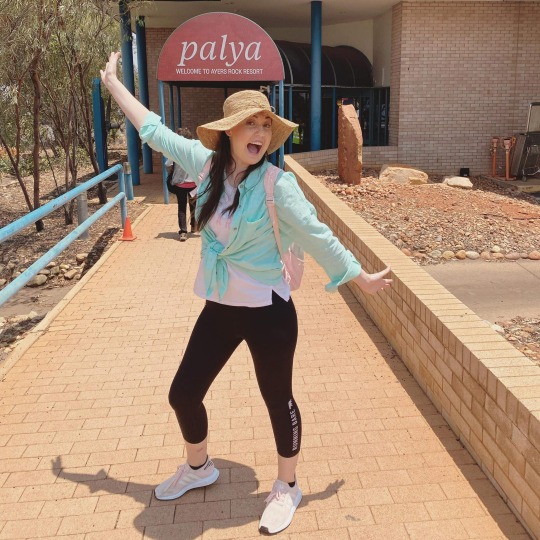
Mum and I checked into our hotel and by that point we were both starving so we decided to have lunch by the pool, I had Mushroom Gnocchi and my Mum had the Ancient Grains Salad. The gnocchi was delicious!!! I almost licked my plate clean it was so good.
Mushroom Gnocchi

After lunch we both had a nice long dip in the pool, which was so refreshing as it was so incredibly hot outside.
Ready For A Dip In The Pool

That night we both went down to Gecko's Cafe which is located in the Town Square for dinner, I had a chicken schnitzel and Mum had a vegetarian pizza. I forgot to take photos of our dinner as I was so tired by that point, sorry about that.
Going Out For Dinner
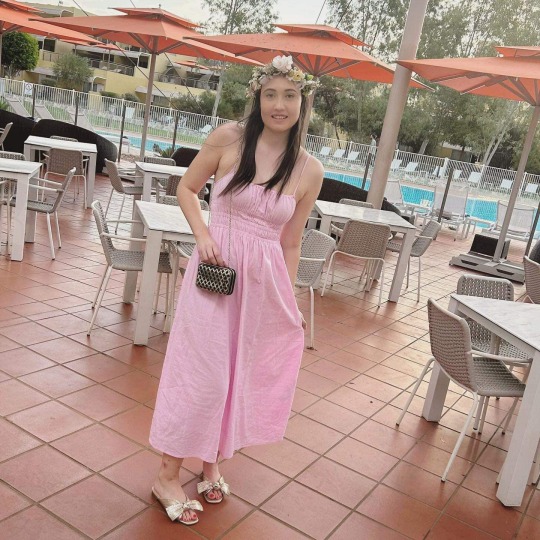
COSTS Lunch: $32.00 Dinner: $26.00
DAY TWO Date: 7/11/2023 Weather: Day: 32 Degrees Night: 21 Degrees Humidity: Day: 15% Night: 18% Itinerary: Uluru
Day two was all about what we had travelled all the way to Yulara for, seeing Uluru. We started our day nice and early, so that we could do the 10 kilometre base walk around Uluru. If you are planning on doing the base walk, it is important that you go either early morning at sunrise or sunset, it is not safe to do it in the middle of the day as it gets extremely hot and there is no shade. Also make sure you pack plenty of water and Gatorade as well as wear appropriate clothing (information on appropriate clothing in "Tips") to avoid dehydration, heat exhaustion and heat stroke.
We got on the Hop On Hop Off bus at 7:00AM and arrived at Uluru in 25 minutes, note that Uluru is inside Uluru Kata Tjuta National Park and you need a ticket to enter the park, you can buy a ticket online or you can do what we did which is go to to the Town Square and buy a ticket at the tourist office.
When we arrived at Uluru, I was at a loss for words, the rock is huge and just feels so magical. They say the rock changes colour throughout the day and I can confirm that is 100% true, I could see Uluru as we entered the park by the bus and it looked purple but by the time we actually arrived at the rock it was bright orange.
Uluru


As we embarked on our walk, admiring the monolith, we came across some signs which told a story about an event that took place here thousands of years ago, I would share the photos but thanks to Tumblr's stupid 30 photos per post limit I can't so I will type out the story for you.
"In the beginning, the Mala people came from the north and could see this rock. They thought it looked like a good place to stay a while and make inma (ceremony). The Mala men decorated and raised Ngaltawata, the ceremonial pole. The inma had now begun.
The Mala people began to busily prepare for their ceremonies. The women gathered and prepared food for everyone. They stored nyuma (seed cakes) in their caves. The men went out hunting. They made fires and fixed their tools and weapons.
In the middle of preparations, two Wintalka men approached from the west. They invited the Mala people to attend their inma. The Mala people said no, explaining their ceremony had begun and could not be stopped.
The Disappointed Wintalka men went back and told their people. Enraged, they created an evil spirit - a huge devil - dog called Kurpany to destroy the Mala inma.
As Kurpany travelled towards the Mala people he changed into many forms. He was a mamu, a ghost. Luunpa the kingfisher woman was the first to spot him. She warned the Mala people but they didn't listen.
Kurpany arrived and attacked and killed some of the men. In great fear and confusion the remaining Mala people fled down into South Australia with Kurpany chasing them. The story continues down south.
These ancestors are still here today. Luunpa still keeps watch, but she is now a large rock. Kurpany's footprints are imprinted into the rock leading towards the east and south. The men who were killed are still in their cave.
This story teaches that it is important to finish what you start and that you should watch for and listen to warnings of danger."
There are certain parts of Uluru that you cannot photograph, these places are clearly marked with signs asking that you not take photographs, this is around the north - east face of Uluru. The reason for this is that the rock details and features at these sites are equivalent to sacred scripture for the Anangu - they describe culturally important information that should only be viewed in their original location and by specific people.
Throughout the walk, there are emergency phones and seats with wooden shelters over them should you become ill or injured and require help. About 9 km's into the walk, I began to suffer from heat exhaustion, luckily for me it was only very mild and I recovered quickly and was able to finish the walk but do be mindful that heat exhaustion is a possibility on this walk.
Me Towards The End Of The 10km Base Walk
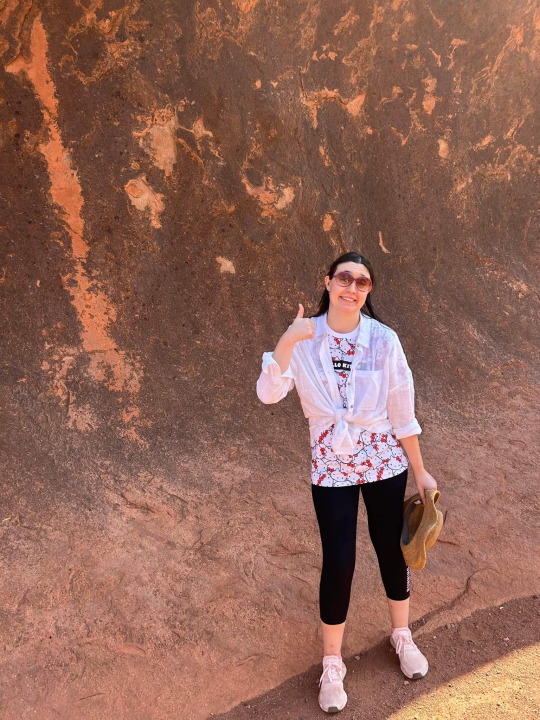
Once we had completed the walk, we got the bus back to our hotel, we both had a much needed swim before we had lunch, we ate by the pool again and i had the mushroom gnocchi again.
That night, we were booked to go and see the Field Of Lights, however a huge wind storm picked up and all of the outdoor night tours including the Field Of Lights got cancelled. We decided to instead have a buffet dinner at out restaurant, Sails In The Desert has a buffet dinner every night, it costs $89.00 per person. It was the best buffet I have ever seen!!! such a great variety and everything was delicious, I had hokkien noodles, arrabiata, truffled cauliflower and garlic and rosemary focaccia. They also had a desert station with a huge chocolate fountain!!! I had ice cream and chocolate and two small slices of chocolate cake.
Dressed And Ready For The Field Of Lights
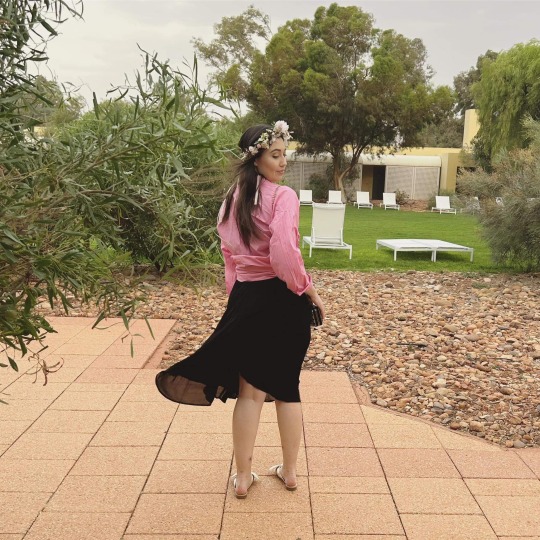
The Amazing Buffet Dinner

COSTS Uluru Kata Tjura National Park Pass: $38.00 Lunch: $32.00 Dinner: $89.00
DAY THREE Date: 8/11/2023 Weather: Day: 32 Degrees Night: 20 Degrees Humidity: Day: 19% Night: 12% Itinerary: Bush Yarn Gallery Of Central Australia Mangata Field Of Lights
The next day we decided to go into the Town Square and attend the 10:00AM Bush Yarn where an Anangu man explained the use and production of tools used by Anangu men. The tools we were introduced to were
Kali - The Kali is what the Anangu call a boomerang, unlike other boomerangs, the kali does not return when thrown. it is used for hunting.
Miru (Spear Thrower) - The Miru is a mulipurpose tool, it is used for hunting, making fires, spear sharpening, mixing ochre and digging.
Kulata (Spear) - Used for hunting.
Kali & Two Miru
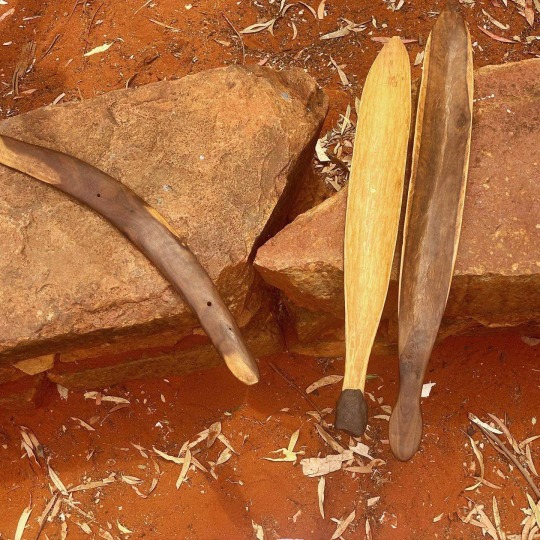
Kulata
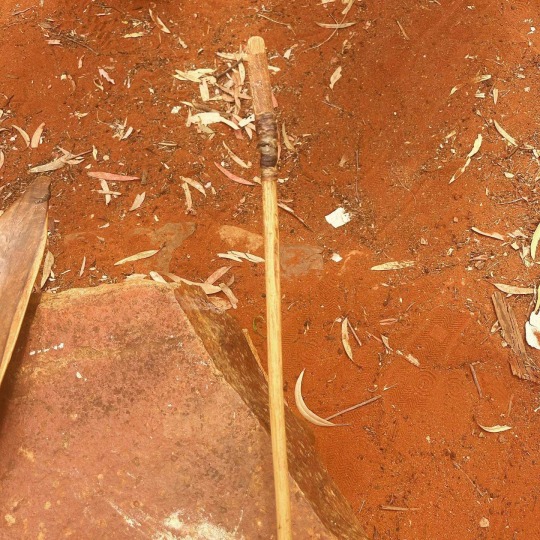
After listening to the Bush Yarn, we got on the Hop On Hop Off bus and went and checked out all of the other hotels, there are 5 hotels within Ayer's Rock Resort and a campground. - Desert Gardens - Emu Walk Apartments - The Lost Camel Hotel - Sails In The Desert - Outback Hotel & Lodge
When we got to the Desert Gardens Hotel, we discovered the Gallery Of Central Australia (GOCA), a small art gallery which showcases absolutely beautiful works of art by local Indigenous artists. In the middle of the gallery, were two Indigenous women working on beautiful paintings. You can buy some of the artworks and there is also a little gift shop selling paintings, cards, bags and more. I desperately wanted to buy one of the artworks, I bought a card instead and put it in a beautiful frame.
A Card I Bought & Framed From GOCA

After a tour of the complex, we went back to our hotel for lunch and a swim, i of course had Mushroom Gnocchi!!!
That night, we were booked in to the Field Of Lights which had been cancelled the previous night. The bus picks you up at 8:00PM so we went and had an early dinner beforehand. We went to the Desert Gardens Hotel and ate in their restaurant Mangata, Mum had poached chicken and vegetables and I had spaghetti bolognaise, both of our meals were delicious.
Spaghetti Bolognaise At Mangata
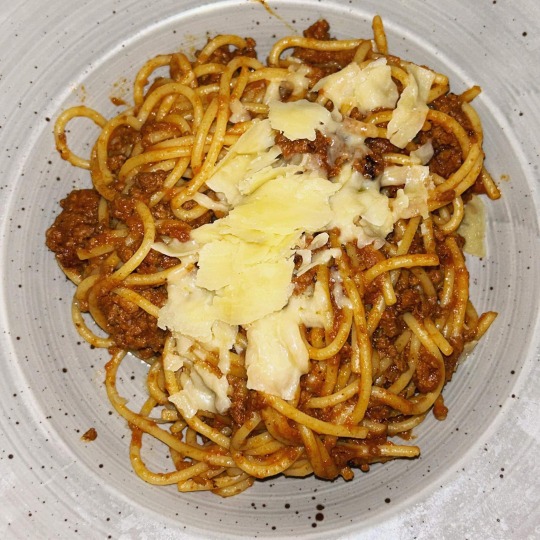
After dinner, the AAT King bus picked us up from our hotel and took us out to the Field Of Lights. The Field Of Lights is a solar powered light installation created by Bruce Monro with more than 300,000 lights covering a vast space of more than seven football fields. This phenomenal installation took over 2,000 hours to design and build in the United Kingdom and then another 3,900 hours to assemble on the site near Uluru. The exhibition first exhibited on the 1st of April 2016 and was scheduled to finish on the 31st of March 2018, however the installation is now permanent thanks to its immense popularity.
Field Of Lights


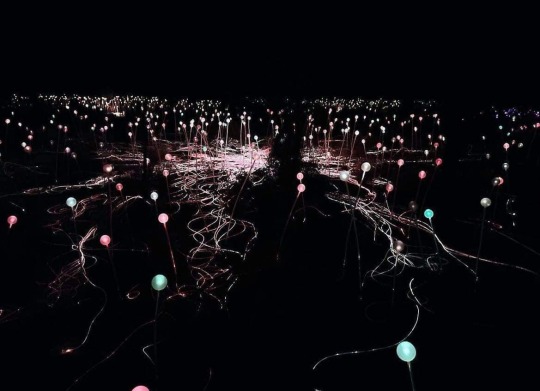
COSTS Lunch: $32.00 Dinner: $29.00 Field Of Lights: $46.00
DAY FOUR Date: 9/11/2023 Weather: Day: 33 Degrees Night: 20 Degrees Humidity: Day: 17% Night: 19% Itinerary: Didgeridoo Workshop
We really didn't do much on our fourth day, we mostly spent the day by the pool just relaxing as we hadn't had much of a chance to do that since arriving at Yulara.
At 11:00AM we went too the Akari theatre outside GOCA and the Didgeridoo workshop, while many people call this instrument a Didgeridoo, Didgeridoo is actually the rhythm produced by playing the instrument, the instruments actual name is Udarki. The man who played the Udarki explained the skilled and proper way to play a Udarki, it is not something you can just pick up and blow into anymore than you can just pick up a guitar and start strumming away, it takes practice and skill to be able to correctly play it. During the demo, Udarkis are handed out to the audience to have a go, however only men are given one as women do not play the Udarki and it is culturally insensitive for women to do so.
COSTS Lunch: $19.50 Dinner: $32.00
DAY FIVE Date: 10/11/2023 Weather: Day: 33 Degrees Night: 20 Degrees Humidity: Day: 12% Night: 19% Itinerary: Paint Your Own Australian Animal Desert Awakenings
Like the previous day, we didn't really do much throughout the day besides swim in the hotel pool, although I did take part in a Paint Your Own Australian Animal workshop in my hotel in which you get given a wooden animal that you paint as well as a guide on Indigenous markings and what they mean. We had also booked to do the Desert Awakenings tour that evening.
My Paintings, The Marking On The Lizard Means Travelling And The Markings On The Platypus Means 2 Women

In the late afternoon, the AAT King bus came and picked us up from our hotel and took us out to Kata Tjuta, the ride there took 37 minutes. Along the way, we stopped off at the Kata Tjuta Sunset Viewing Platform, where we were able to see both Uluru and Kata Tjuta and get some photos, we then got back on the bus and headed to Kata Tjuta.
Mum And I At The Kata Tjuta Sunset Viewing Platform


We arrived at Kata Tjuta and had drinks and canopies whilst sitting and watching the sun set over Kata Tjuta, it was a truly spectacular site. We stayed for an hour, watching Kata Tjuta change from orange to brown to purple, before getting back onto the bus, on the bus ride home, Mum and I were sitting at the front of the bus and were lucky enough to see two King Brown Snakes slithering across the road, I was absolutely stoked as I'm a snake lover.
Kata Tjuta Changing Colours As The Sun Sets

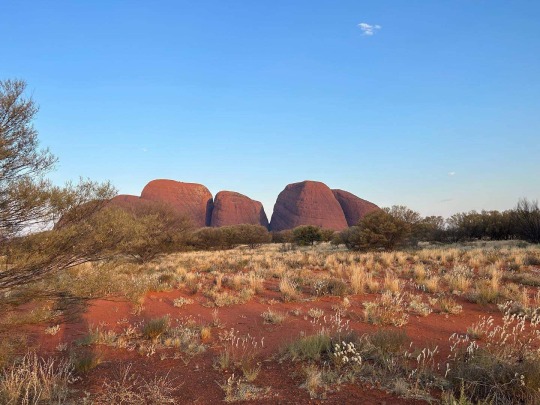

We got back to our hotel and had dinner in the restaurant, I got my final bowl of mushroom gnocchi, and then we went back to our room and began the depressing task of packing up our stuff, ready to leave the next day.
COSTS Lunch: $19.50 Desert Awakenings Tour: $160.00 Dinner: $32.00
TIPS
If you are doing the 10km base walk of Uluru, make sure to wear a hat, a lightweight shirt with sleeves that cover your arms, sunscreen and comfortable walking shoes, avoid wearing black clothing as this will absorb heat.
If you are doing the 10km base walk of Uluru, make sure to pack plenty of water and Gatorade, dehydration, heat exhaustion and heat stroke can occur very easily out here and be dangerous.
Climbing Uluru was banned in 2019 so you cannot climb Uluru, instead admire its beauty from the ground.
Due to its remote location and high overheads, EVERYTHING!!!! is expensive, food, souvenirs, tours and basic necessities like sunscreen and tissues, try to take as much of your own stuff as possible and if you're staying somewhere with kitchen facilities, there is an IGA so preparing your own food is an option for cutting down on costs.
The Sun is harsh and extreme, be sure to consistently keep up with sunscreen application and wear a hat. When possible wear long sleeves and long pants/dresses/skirts, the less sun on your skin the better
The Hop On Hop Off Bus is free and operates every 20 minutes, making a stop at every accomodation.
CULTURAL INFORMATION AND SENSITIVITIES
Ensure you have permission before photographing any of the Anangu.
Whilst some Anangu may give you permission to take a photo, you must NEVER!!! film them
Do not photograph or enter any sacred sites.
Anangu greet each other by saying "palya" a word which can also mean welcome, thank you, understood, ok and goodbye.
Do not refer to Uluru as Ayer's Rock or Kata Tjuta as The Olgas.
The Anangu honour their dead by not speaking their names or looking at their pictures, it is believed that doing so will recall and disturb the spirit.
HISTORY OF ULURU KATA TJUTA NATIONAL PARK The mesmerising monolith known as Uluru was created over 600 million years ago. While Indigenous Australians date back 60,000 years, the Anangu have lived in the area and used Uluru and Kata Tjuta for sacred ceremonies and rites of passage for the last 10,000 years. The caves and crevices of the monolith contain many sacred areas and ancient rock paintings. Before European invasion which took place in 1770, Indigenous Australians spoke an estimated 700 dialects. Today, only 20 - 50 languages remain and are spoken by children. Anangu mainly speak Pitjantjatjara and Yankunytjatjara, although some speak up to six of the Aboriginal languages.
In 1873, William Gosse went on a three month journey from Alice Springs through the desert, which brought him to Uluru, he was the first non Indigenous person to see Uluru and so he named it "Ayer's Rock" after Sir Henry Ayers, the Chief Secretary of South Australia at the time. On October 26th, 1985. Kata Tjuta, was discovered by a non Indigenous person for the first time in 1872 by Ernest Giles. Upon his discovery, Ernest named the collection of mountains "Mount Olga" after Queen Olga of Wurttemberg.
In the 1930's more explorers began arriving and by the 1940's the first graded road was laid. Tourism to the area officially began in the 1950's and over the next few decades, tourism operators started tours, roads were built as well as a small airport.
the Australian government finally returned ownership of the area and the national park back over to its rightful owners the Anangu on the 26th of October 1985. In 2002, the a few name changes were enacted in order to show respect to and acknowledge the Anangu as the traditional owners of the land, Ayer's Rock was changed to Uluru, The Olgas was changed to Kata Tjuta and Ayer's Rock Mount Olga National Park was changed to Uluru Kata Tjuta National Park. The Anangu people do not appreciate people calling Uluru "Ayer's Rock" or Kata Tjuta "The Olga's" as these names were a result of European colonisation and were imposed on a section of Aboriginal country. For this reason, you should always refer to the rock as Uluru and the mountains as Kata Tjuta.
#australia#northern territory#yulara#ayers rock#ayers rock resort#sails in the desert#uluru#uluru kata tjuta national park#bush yarn#anangu#desert gardens hotel#mangata#gallery of central australia#field of lights#kata tjuta#desert awakenings
7 notes
·
View notes
Text
旅記録② in Australia🇦🇺
Uluru,Kata Tjuta編
絶景写真と共に振り返る。
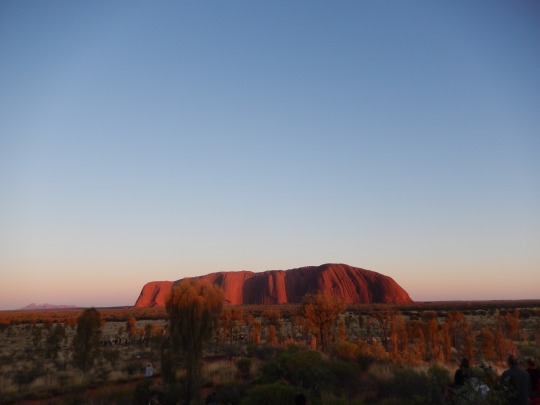

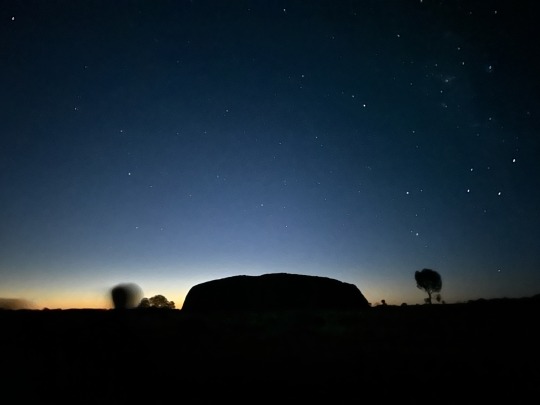
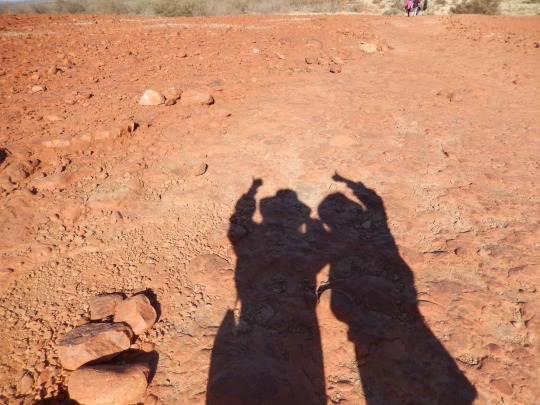
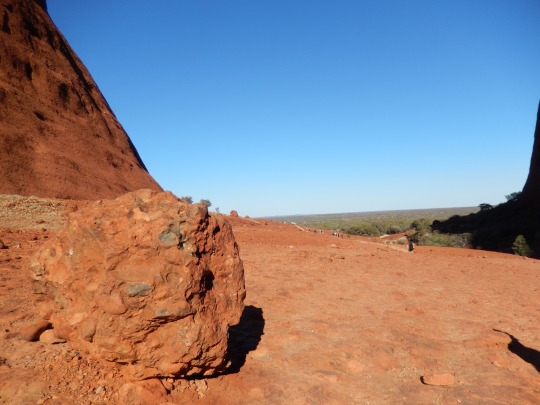
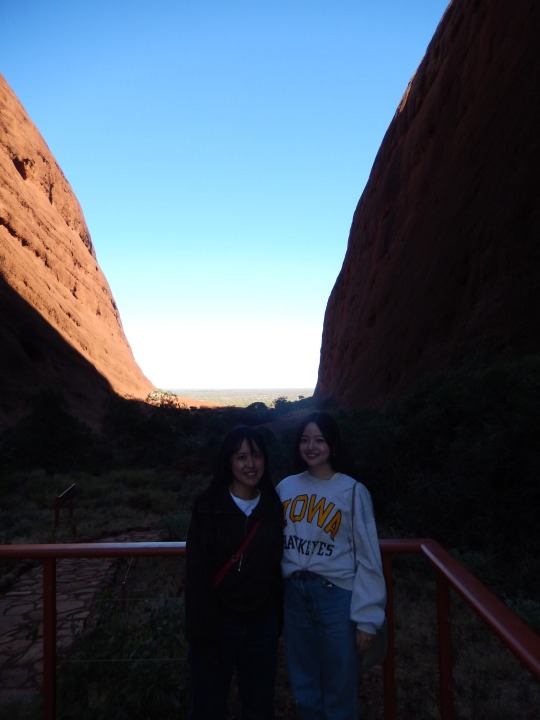
ついに、ずっと行ってみたかったUluruへ。
UluruことAyers Rockは、ノーザンテリトリーの中心にある大きな一枚岩のこと。先住民アナング族にとっての神聖な土地で、約5億年前からある、大きな大きな一枚岩。Uluruは、彼らの言葉で「偉大な岩」という意味。写真だと分かりにくいけど、東京タワーより高いらしい🗼
感想①こんな大きいのが一枚の岩ってやばい、②岩以外マジで何もない、③ハエやばい。
3日間の滞在で、先住民アナング族の歴史を目で見て、耳で聞いて、かなり深く知ることができた。
(アナング族のことを白人はアボリジニと呼ぶけど、これは差別用語で、Australiaの人たちは皆『Anangu』とか『first nations(最初に住んでいた人)』って呼ぶらしい。)
アナングの人たちは文字を持たないから、昔話で子供たちに文化や歴史を伝えていくとのこと。たくさんのストーリーを教わったけど、物語に含まれる教えはどれも、どの時代でもどの地域でも共通なんだな〜って感じて、面白かった。(例えば、女の人の勘は当たる、嫌な予感は現実になる、人の忠告は聞け、謝られたら許せ、などなど)
世界遺産を見にいくなら、絶対に歴史を一緒に学んだ方が良いなと改めて痛感。おかげさまで、実り大きい観光になった。
朝4時に起きてバスで2時間ほど移動して拝んだ景色。朝日に照らされる一枚岩。↓
一生に���度は見たい景色だったので、もう訪れることがあるのかは分からないけど(旅費高いし)、でも一生忘れられない景色だったのは確かで。
雄大なランドマークの迫力がえげつなくて、ホッとため息が出る美しさ。自分が日常で感じてるモヤモヤとかって大したことないんだなってリアルに感じた。
自分の両親がまだ足腰元気なうちに、ぜひ行ってほしいな〜って思った^^
ハエよけ帽子は絶対みんな持って行った方がいいです。快適さがちがいます。
7 notes
·
View notes
Text
"Uluru: Australia's Sacred Monolith and Natural Wonder"
Uluru, also known as Ayers Rock, is a world-famous monolith that sits at the heart of Australia’s Red Centre. This majestic sandstone formation, rich in indigenous culture and surrounded by breathtaking landscapes, is a prime destination for travelers seeking a unique blend of natural beauty, spirituality, and adventure. The Marvel of Uluru: Uluru, rising over 1,100 feet and stretching for more…

View On WordPress
#Australia#Kata Tjuta#Ranger of Miles#rangerofmiles#tourism#tourist#Travel#Uluru#Uluru-Kata Tjuta National Park#vacation
2 notes
·
View notes
Text
Uluru in context
On our last tour day at Yulara we were treated to a helicopter ride so we could see Uluru from the air. It stands out, a huge rock in a red desert, as though some God had plucked it out from somewhere else and placed it on the plain. Kata Tjuta looks like a pile of pebbles such as a child might make on a beach. So – what are they? How did they get to be there? The Anangu people, the traditional…
0 notes
Text

Model of the Set of 3 famous Australian landmarks.
Link to see more about this model on Turbosquid.com:
https://www.turbosquid.com/3d-models/3-australian-landmarks-2017474?referral=amanitacz
Link to the whole gallery:
https://www.turbosquid.com/Search/Artists/AmanitaCZ?referral=amanitacz
Link to the software:
http://www.cazaba.cz/
#graphic#computer graphics#amanitacz#cazaba#3d#model#3d model#TurboSquid#geology#mountain#rock#uluru#ayers#kata tjuta#olgas#conner#australia#landmark#landscape#terrain
0 notes
Video
1 note
·
View note
Text
The highest point of Kata Tjuta is 546m above the surrounding plane (nearly 200m taller than Uluṟu).
This pic gets all of it in, but you’ll need to work out a scale for how huge it is.
Seen here under warm winter clouds.

11 notes
·
View notes
Note
Favorite skink?
WHAT???? FAVORITE SKINK BABIES???
I cannot shoose! Here are some favorites...

Eastern Shingleback Skink (Tiliqua rugosa asper), family Scincidae, South Australia
photograph by Benjamint444

Emerald Tree Skink (Lamprolepis smaragdina), family Scincidae, Jasaan, Misamis Oriental, Philippines
photograph by Domzjuniorwildlife

Haly’s Tree Skink (Dasia haliana), family Scincidae, endemic to Sri Lanka
photographs by Dushantha Kandambi [a,b] and A. Jayasooriya [c]


Prickly Forest Skink (Gnypetoscincus queenslandiae), family Scincidae, endemic to rainforests of Queensland, Australia
photograph by Shane Walsh

Fire Skink (Mochlus fernandi), family Scincidae, found in West Africa
* Also known by the scientific name Riopa fernandi.
Photograph by Reptiles 4All

The Sandfish (Scincus scincus), family Scincidae, northern Africa
photograph by Wilfried Berns


Solomon Island Prehensile-tailed Skink (Corucia zebrata), family Scincidae, endemic to the Solomon Islands archipelago
Arboreal, herbivorous, crepuscular.
The largest known species of skink, they can grow to a total length of 32 inches (81 cm).
Live-bearing, they provide parental care for the young, after birth, as well. Females are known to be fiercely protective of the young.
They are actually social, and live in extended family groups.
This has been scientifically proven to be one of the best lizards, and I love them.
photograph by Josh More

Yellow-belly Three-toed Skink (Saiphos equalis), family Scincidae, found in eastern Australia
The only species in this genus.
Coastal populations reproduce by laying eggs (oviparity), and mountain populations reproduce through live birth (viviparity).
photograph by Rebecca Pyles

McCoy’s Elf Skink aka Highlands Forest Skink (Anepischetosia maccoyi), family Scincidae, Australia
photograph by @skinkmania__

Great Desert Skink aka Kintore’s Skink (Liopholis kintorei), family Scincidae, Kata Tjuta Nat Park, NT, Australia
These lizards live cooperatively in underground burrow systems, with siblings and offspring, as well as with unrelated individuals and pairs.
photograph by Gary Stephenson

Red-eyed Crocodile Skink (Tribolonotus gracilis), family Scincidae, endemic to New Guinea
photograph by Rizki Supendi

Banded Supple Skink (Lygosoma haroldyoungi), family Scincidae, Northern Thailand
Photograph by Rupert Grassby-Lewis
821 notes
·
View notes
Text
YULARA - ULURU KATA TJUTA NATIONAL PARK 2023
I have just returned from a trip to Yulara. My trip was so amazing and the place so special that I felt it deserved a blog post so here it is.
PS - Tumblr have put a new restriction on how many photos you can put in a blog post, so sadly I won't be able to post as many photos in the post as I did my Singapore post, Stupid Tumblr :(
Yulara and Uluru Kata Tjuta National Park is owned by Anangu, the traditional custodians of the land.
DAY ONE Date: 6/11/2023 Weather: Day: 35 Degrees Night: 32 Degrees Humidity: Day: 32% Night: 16% Itinerary: Arrive At Yulara Check Into Hotel - Sails In The Desert Gecko's Cafe
The trip start at Sydney Domestic Airport on the 6th of November, my Mother and I flew from Sydney to Yulara via Jetstar. The flight to Yulara was 3 hours, I would like to give a shoutout to manager Pat and the crew on our flight, all of them were super friendly and lovely to talk to and made the flight a really lovely experience.
Just like Singapore, the minute the plane landed and we stepped off the plane I immediately noticed the heat. Unlike Singapore which is a very humid heat, the heat in Yulara is extremely dry, according to my phone it was 35 degrees and the humidity was 32%. Apart from the heat, the other thing I noticed was the bright red sand and dust, letting me know that I was indeed in the Red Centre. We got our luggage and then got on to the Hop On Hop Off bus to our hotel in the Ayer's Rock Resort complex, we were staying at Sails In The Desert. I want to take a moment here to say that the rock is NOT!!! Called Ayer's Rock it's called Uluru, it used to be called Ayer's Rock however that name was changed to Uluru in 2002, I'll explain why at the bottom of this post but just remember to call it Uluru and not Ayer's Rock as the local Anangu do not appreciate people referring to the rock by its old name. The resort complex however is called "Ayer's Rock Resort"
Arriving At Yulara
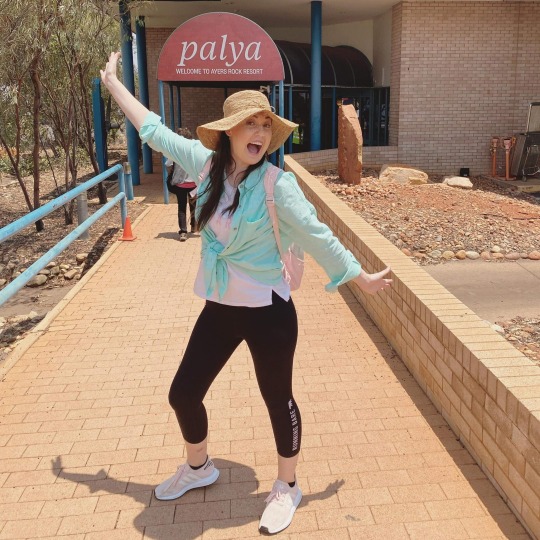
Mum and I checked into our hotel and by that point we were both starving so we decided to have lunch by the pool, I had Mushroom Gnocchi and my Mum had the Ancient Grains Salad. The gnocchi was delicious!!! I almost licked my plate clean it was so good.
Mushroom Gnocchi

After lunch we both had a nice long dip in the pool, which was so refreshing as it was so incredibly hot outside.
Ready For A Dip In The Pool

That night we both went down to Gecko's Cafe which is located in the Town Square for dinner, I had a chicken schnitzel and Mum had a vegetarian pizza. I forgot to take photos of our dinner as I was so tired by that point, sorry about that.
Going Out For Dinner

COSTS Lunch: $32.00 Dinner: $26.00
DAY TWO Date: 7/11/2023 Weather: Day: 32 Degrees Night: 21 Degrees Humidity: Day: 15% Night: 18% Itinerary: Uluru
Day two was all about what we had travelled all the way to Yulara for, seeing Uluru. We started our day nice and early, so that we could do the 10 kilometre base walk around Uluru. If you are planning on doing the base walk, it is important that you go either early morning at sunrise or sunset, it is not safe to do it in the middle of the day as it gets extremely hot and there is no shade. Also make sure you pack plenty of water and Gatorade as well as wear appropriate clothing (information on appropriate clothing in "Tips") to avoid dehydration, heat exhaustion and heat stroke.
We got on the Hop On Hop Off bus at 7:00AM and arrived at Uluru in 25 minutes, note that Uluru is inside Uluru Kata Tjuta National Park and you need a ticket to enter the park, you can buy a ticket online or you can do what we did which is go to to the Town Square and buy a ticket at the tourist office.
When we arrived at Uluru, I was at a loss for words, the rock is huge and just feels so magical. They say the rock changes colour throughout the day and I can confirm that is 100% true, I could see Uluru as we entered the park by the bus and it looked purple but by the time we actually arrived at the rock it was bright orange.
Uluru
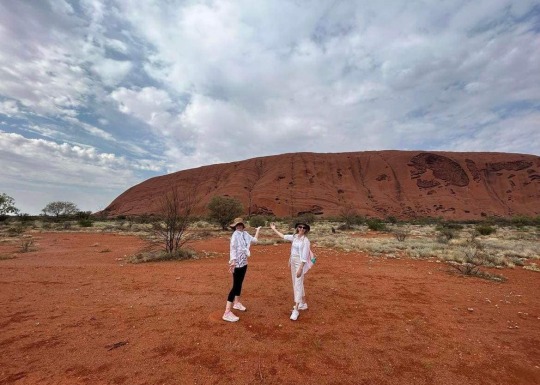
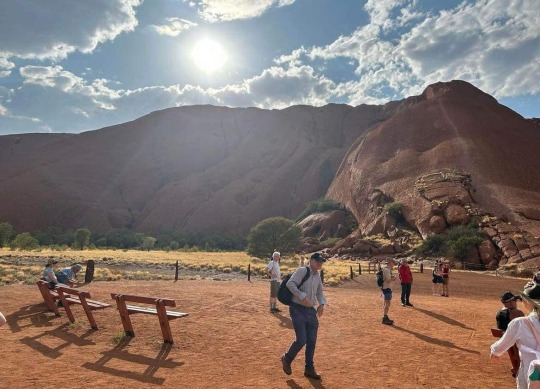
As we embarked on our walk, admiring the monolith, we came across some signs which told a story about an event that took place here thousands of years ago, I would share the photos but thanks to Tumblr's stupid 30 photos per post limit I can't so I will type out the story for you.
"In the beginning, the Mala people came from the north and could see this rock. They thought it looked like a good place to stay a while and make inma (ceremony). The Mala men decorated and raised Ngaltawata, the ceremonial pole. The inma had now begun.
The Mala people began to busily prepare for their ceremonies. The women gathered and prepared food for everyone. They stored nyuma (seed cakes) in their caves. The men went out hunting. They made fires and fixed their tools and weapons.
In the middle of preparations, two Wintalka men approached from the west. They invited the Mala people to attend their inma. The Mala people said no, explaining their ceremony had begun and could not be stopped.
The Disappointed Wintalka men went back and told their people. Enraged, they created an evil spirit - a huge devil - dog called Kurpany to destroy the Mala inma.
As Kurpany travelled towards the Mala people he changed into many forms. He was a mamu, a ghost. Luunpa the kingfisher woman was the first to spot him. She warned the Mala people but they didn't listen.
Kurpany arrived and attacked and killed some of the men. In great fear and confusion the remaining Mala people fled down into South Australia with Kurpany chasing them. The story continues down south.
These ancestors are still here today. Luunpa still keeps watch, but she is now a large rock. Kurpany's footprints are imprinted into the rock leading towards the east and south. The men who were killed are still in their cave.
This story teaches that it is important to finish what you start and that you should watch for and listen to warnings of danger."
There are certain parts of Uluru that you cannot photograph, these places are clearly marked with signs asking that you not take photographs, this is around the north - east face of Uluru. The reason for this is that the rock details and features at these sites are equivalent to sacred scripture for the Anangu - they describe culturally important information that should only be viewed in their original location and by specific people.
Throughout the walk, there are emergency phones and seats with wooden shelters over them should you become ill or injured and require help. About 9 km's into the walk, I began to suffer from heat exhaustion, luckily for me it was only very mild and I recovered quickly and was able to finish the walk but do be mindful that heat exhaustion is a possibility on this walk.
Me Towards The End Of The 10km Base Walk
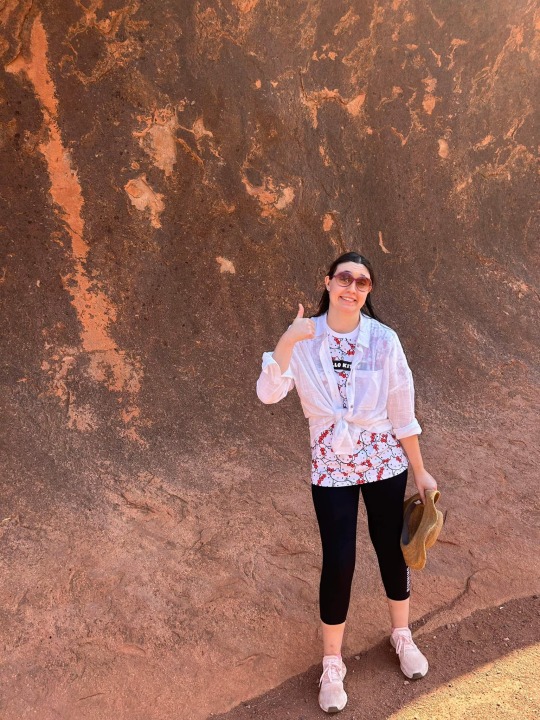
Once we had completed the walk, we got the bus back to our hotel, we both had a much needed swim before we had lunch, we ate by the pool again and i had the mushroom gnocchi again.
That night, we were booked to go and see the Field Of Lights, however a huge wind storm picked up and all of the outdoor night tours including the Field Of Lights got cancelled. We decided to instead have a buffet dinner at out restaurant, Sails In The Desert has a buffet dinner every night, it costs $89.00 per person. It was the best buffet I have ever seen!!! such a great variety and everything was delicious, I had hokkien noodles, arrabiata, truffled cauliflower and garlic and rosemary focaccia. They also had a desert station with a huge chocolate fountain!!! I had ice cream and chocolate and two small slices of chocolate cake.
Dressed And Ready For The Field Of Lights
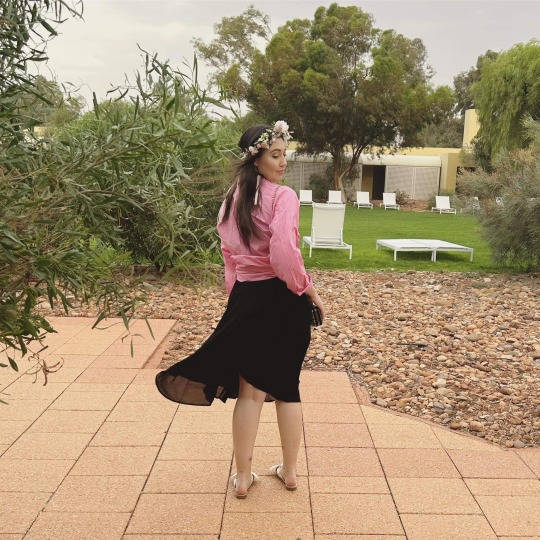
The Amazing Buffet Dinner

COSTS Uluru Kata Tjura National Park Pass: $38.00 Lunch: $32.00 Dinner: $89.00
DAY THREE Date: 8/11/2023 Weather: Day: 32 Degrees Night: 20 Degrees Humidity: Day: 19% Night: 12% Itinerary: Bush Yarn Gallery Of Central Australia Mangata Field Of Lights
The next day we decided to go into the Town Square and attend the 10:00AM Bush Yarn where an Anangu man explained the use and production of tools used by Anangu men. The tools we were introduced to were
Kali - The Kali is what the Anangu call a boomerang, unlike other boomerangs, the kali does not return when thrown. it is used for hunting.
Miru (Spear Thrower) - The Miru is a mulipurpose tool, it is used for hunting, making fires, spear sharpening, mixing ochre and digging.
Kulata (Spear) - Used for hunting.
Kali & Two Miru
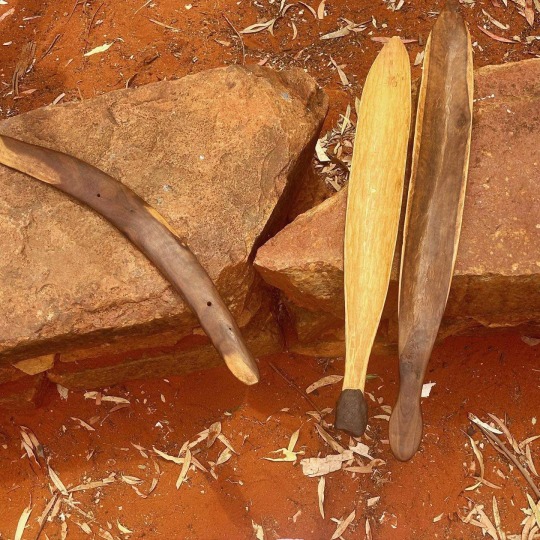
Kulata

After listening to the Bush Yarn, we got on the Hop On Hop Off bus and went and checked out all of the other hotels, there are 5 hotels within Ayer's Rock Resort and a campground. - Desert Gardens - Emu Walk Apartments - The Lost Camel Hotel - Sails In The Desert - Outback Hotel & Lodge
When we got to the Desert Gardens Hotel, we discovered the Gallery Of Central Australia (GOCA), a small art gallery which showcases absolutely beautiful works of art by local Indigenous artists. In the middle of the gallery, were two Indigenous women working on beautiful paintings. You can buy some of the artworks and there is also a little gift shop selling paintings, cards, bags and more. I desperately wanted to buy one of the artworks, I bought a card instead and put it in a beautiful frame.
A Card I Bought & Framed From GOCA
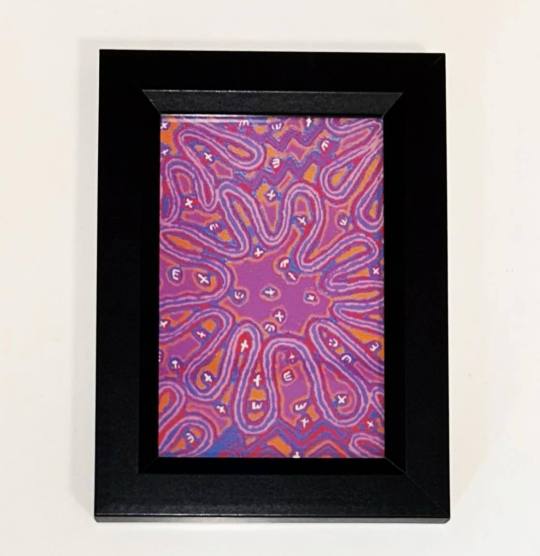
After a tour of the complex, we went back to our hotel for lunch and a swim, i of course had Mushroom Gnocchi!!!
That night, we were booked in to the Field Of Lights which had been cancelled the previous night. The bus picks you up at 8:00PM so we went and had an early dinner beforehand. We went to the Desert Gardens Hotel and ate in their restaurant Mangata, Mum had poached chicken and vegetables and I had spaghetti bolognaise, both of our meals were delicious.
Spaghetti Bolognaise At Mangata
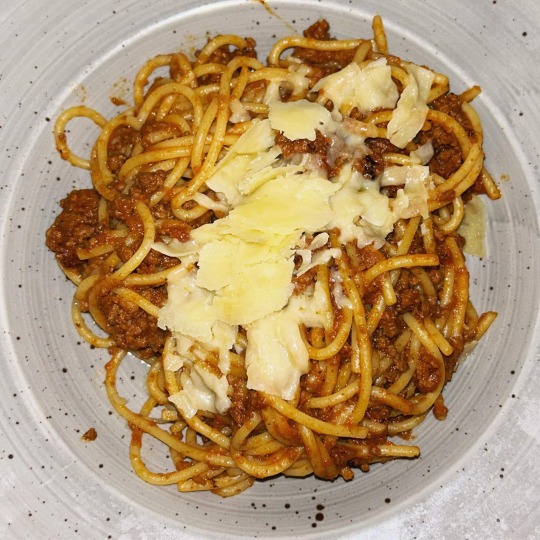
After dinner, the AAT King bus picked us up from our hotel and took us out to the Field Of Lights. The Field Of Lights is a solar powered light installation created by Bruce Monro with more than 300,000 lights covering a vast space of more than seven football fields. This phenomenal installation took over 2,000 hours to design and build in the United Kingdom and then another 3,900 hours to assemble on the site near Uluru. The exhibition first exhibited on the 1st of April 2016 and was scheduled to finish on the 31st of March 2018, however the installation is now permanent thanks to its immense popularity.
Field Of Lights

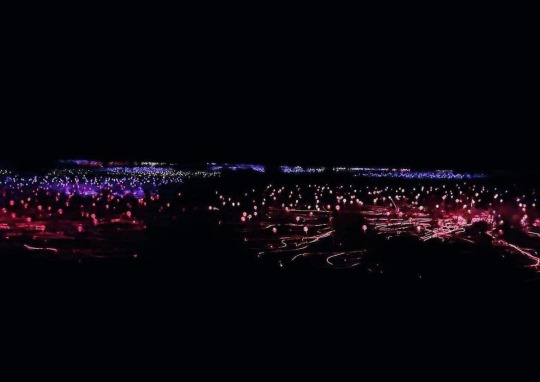
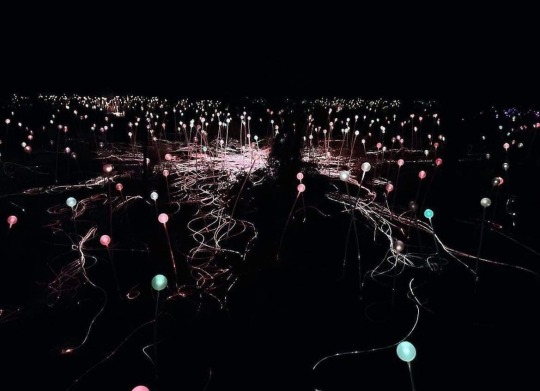
COSTS Lunch: $32.00 Dinner: $29.00 Field Of Lights: $46.00
DAY FOUR Date: 9/11/2023 Weather: Day: 33 Degrees Night: 20 Degrees Humidity: Day: 17% Night: 19% Itinerary: Didgeridoo Workshop
We really didn't do much on our fourth day, we mostly spent the day by the pool just relaxing as we hadn't had much of a chance to do that since arriving at Yulara.
At 11:00AM we went too the Akari theatre outside GOCA and the Didgeridoo workshop, while many people call this instrument a Didgeridoo, Didgeridoo is actually the rhythm produced by playing the instrument, the instruments actual name is Udarki. The man who played the Udarki explained the skilled and proper way to play a Udarki, it is not something you can just pick up and blow into anymore than you can just pick up a guitar and start strumming away, it takes practice and skill to be able to correctly play it. During the demo, Udarkis are handed out to the audience to have a go, however only men are given one as women do not play the Udarki and it is culturally insensitive for women to do so.
COSTS Lunch: $19.50 Dinner: $32.00
DAY FIVE Date: 10/11/2023 Weather: Day: 33 Degrees Night: 20 Degrees Humidity: Day: 12% Night: 19% Itinerary: Paint Your Own Australian Animal Desert Awakenings
Like the previous day, we didn't really do much throughout the day besides swim in the hotel pool, although I did take part in a Paint Your Own Australian Animal workshop in my hotel in which you get given a wooden animal that you paint as well as a guide on Indigenous markings and what they mean. We had also booked to do the Desert Awakenings tour that evening.
My Paintings, The Marking On The Lizard Means Travelling And The Markings On The Platypus Means 2 Women

In the late afternoon, the AAT King bus came and picked us up from our hotel and took us out to Kata Tjuta, the ride there took 37 minutes. Along the way, we stopped off at the Kata Tjuta Sunset Viewing Platform, where we were able to see both Uluru and Kata Tjuta and get some photos, we then got back on the bus and headed to Kata Tjuta.
Mum And I At The Kata Tjuta Sunset Viewing Platform

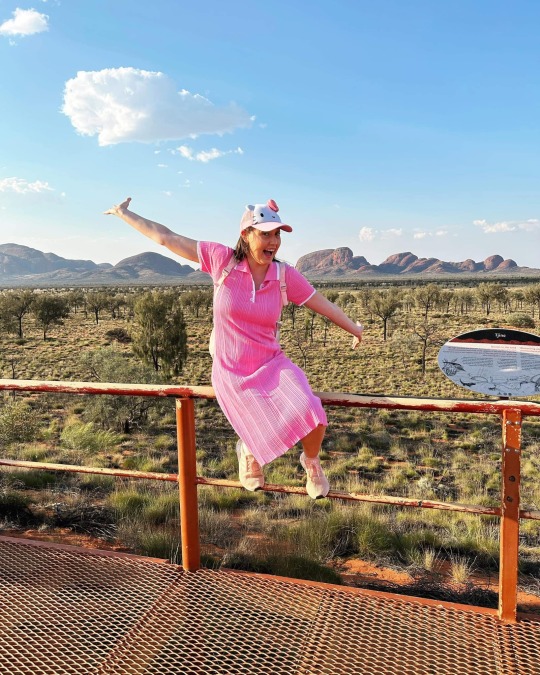
We arrived at Kata Tjuta and had drinks and canopies whilst sitting and watching the sun set over Kata Tjuta, it was a truly spectacular site. We stayed for an hour, watching Kata Tjuta change from orange to brown to purple, before getting back onto the bus, on the bus ride home, Mum and I were sitting at the front of the bus and were lucky enough to see two King Brown Snakes slithering across the road, I was absolutely stoked as I'm a snake lover.
Kata Tjuta Changing Colours As The Sun Sets
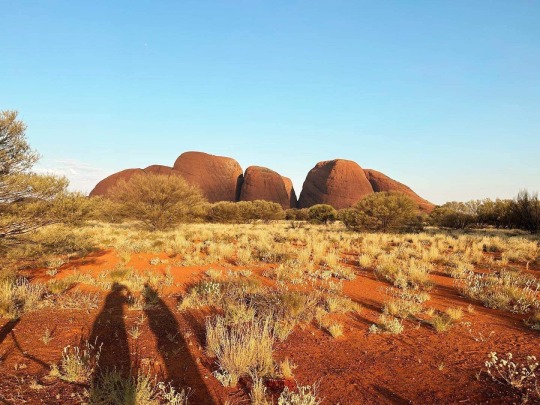
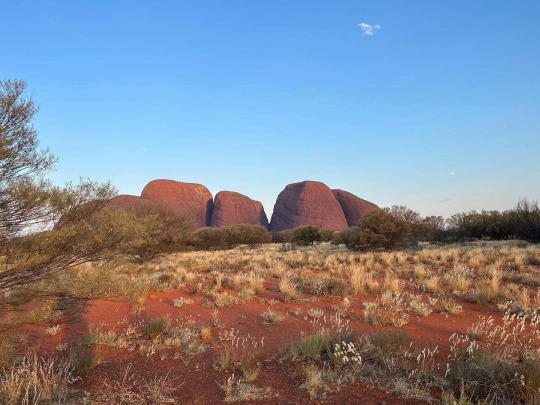
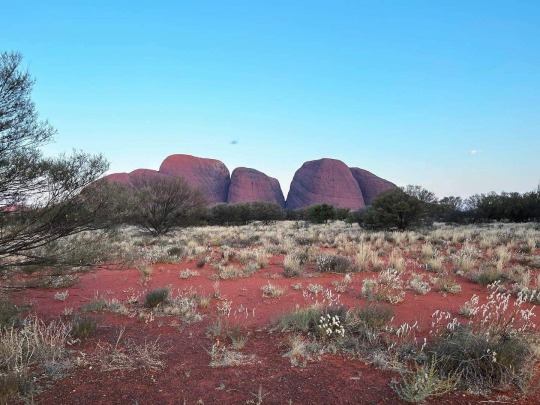
We got back to our hotel and had dinner in the restaurant, I got my final bowl of mushroom gnocchi, and then we went back to our room and began the depressing task of packing up our stuff, ready to leave the next day.
COSTS Lunch: $19.50 Desert Awakenings Tour: $160.00 Dinner: $32.00
TIPS
If you are doing the 10km base walk of Uluru, make sure to wear a hat, a lightweight shirt with sleeves that cover your arms, sunscreen and comfortable walking shoes, avoid wearing black clothing as this will absorb heat.
If you are doing the 10km base walk of Uluru, make sure to pack plenty of water and Gatorade, dehydration, heat exhaustion and heat stroke can occur very easily out here and be dangerous.
Climbing Uluru was banned in 2019 so you cannot climb Uluru, instead admire its beauty from the ground.
Due to its remote location and high overheads, EVERYTHING!!!! is expensive, food, souvenirs, tours and basic necessities like sunscreen and tissues, try to take as much of your own stuff as possible and if you're staying somewhere with kitchen facilities, there is an IGA so preparing your own food is an option for cutting down on costs.
The Sun is harsh and extreme, be sure to consistently keep up with sunscreen application and wear a hat. When possible wear long sleeves and long pants/dresses/skirts, the less sun on your skin the better
The Hop On Hop Off Bus is free and operates every 20 minutes, making a stop at every accomodation.
CULTURAL INFORMATION AND SENSITIVITIES
Ensure you have permission before photographing any of the Anangu.
Whilst some Anangu may give you permission to take a photo, you must NEVER!!! film them
Do not photograph or enter any sacred sites.
Anangu greet each other by saying "palya" a word which can also mean welcome, thank you, understood, ok and goodbye.
Do not refer to Uluru as Ayer's Rock or Kata Tjuta as The Olgas.
The Anangu honour their dead by not speaking their names or looking at their pictures, it is believed that doing so will recall and disturb the spirit.
HISTORY OF ULURU KATA TJUTA NATIONAL PARK The mesmerising monolith known as Uluru was created over 600 million years ago. While Indigenous Australians date back 60,000 years, the Anangu have lived in the area and used Uluru and Kata Tjuta for sacred ceremonies and rites of passage for the last 10,000 years. The caves and crevices of the monolith contain many sacred areas and ancient rock paintings. Before European invasion which took place in 1770, Indigenous Australians spoke an estimated 700 dialects. Today, only 20 - 50 languages remain and are spoken by children. Anangu mainly speak Pitjantjatjara and Yankunytjatjara, although some speak up to six of the Aboriginal languages.
In 1873, William Gosse went on a three month journey from Alice Springs through the desert, which brought him to Uluru, he was the first non Indigenous person to see Uluru and so he named it "Ayer's Rock" after Sir Henry Ayers, the Chief Secretary of South Australia at the time. On October 26th, 1985. Kata Tjuta, was discovered by a non Indigenous person for the first time in 1872 by Ernest Giles. Upon his discovery, Ernest named the collection of mountains "Mount Olga" after Queen Olga of Wurttemberg.
In the 1930's more explorers began arriving and by the 1940's the first graded road was laid. Tourism to the area officially began in the 1950's and over the next few decades, tourism operators started tours, roads were built as well as a small airport.
the Australian government finally returned ownership of the area and the national park back over to its rightful owners the Anangu on the 26th of October 1985. In 2002, the a few name changes were enacted in order to show respect to and acknowledge the Anangu as the traditional owners of the land, Ayer's Rock was changed to Uluru, The Olgas was changed to Kata Tjuta and Ayer's Rock Mount Olga National Park was changed to Uluru Kata Tjuta National Park. The Anangu people do not appreciate people calling Uluru "Ayer's Rock" or Kata Tjuta "The Olga's" as these names were a result of European colonisation and were imposed on a section of Aboriginal country. For this reason, you should always refer to the rock as Uluru and the mountains as Kata Tjuta.
#australia#northern territory#yulara#ayers rock#ayers rock resort#sails in the desert#uluru#uluru kata tjuta national park#bush yarn#anangu#desert gardens hotel#mangata#gallery of central australia#field of lights#kata tjuta#desert awakenings#2023
1 note
·
View note
Photo

Dreamtime
Dreamtime (The Dreaming) is the English term used to describe the mythology and spirituality of Indigenous Australians. It is a philosophy, worldview, cosmology, and way of life that explains how the world was created. Although people often associate dreams with Dreamtime, it encompasses much more than that.
The Dreaming is an expansive consciousness that deals with everything from the meaning of life to everything in between. Indigenous Australians differentiate between ordinary dreams and more spiritual ones associated with Dreamtime.
The myths of Dreamtime have been passed down orally for thousands of years and are conveyed through song, storytelling, dance, and art. These myths gave each individual wisdom and purpose. The Dreaming did not take place in the past but is always present in a parallel timeline that continues to nurture the earth. Time and place are infinite in Dreamtime. Indigenous Australians believe that their lives had already been predestined by the spiritual beings of Dreamtime and that it is their duty to live in accordance with those terms.
The Aboriginal Australians & the Land
Aboriginal Australians are made up of various indigenous groups that first arrived in Australia from Asia around 65,000 years ago. They inhabited mainland Australia and its many islands. Each group had its own unique language, traditions, and culture, including different gods and creation stories. Places in modern Australia are tied to specific Indigenous Australian groups; for example, Sydney is the home of the Eora nation, while Melbourne is home to the Wurundjeri people.
Knowledge is not freely available in Indigenous Australian culture and is based on age, gender, and clan membership. Some languages are only spoken by females, and vice versa. There are strict guidelines for everything, including religious ceremonies, land rights, and social relationships.
Indigenous Australians view themselves as custodians of the land rather than its owners. The land is an integral part of Dreamtime, with every aspect of the Australian land carrying signs of the ancestral beings and magic. The grey clouds, the emerald water of the lakes and rivers, and the redness of the dust and rocks all carry elemental qualities. The running waters of the stream remind us of the Rainbow Serpent, who created the streams with her burrowing body. The rock cairns signify the All-Father spirit, Baiame (Biame), who came down from the sky with his sacred law, while the bonfires are reminiscent of the original fire lit by the Sun Mother's hands, and a landslide may tell of a violent battle.
Although the whole land is sacred to Indigenous Australians, some parts are more special or powerful than others. These include Uluru (Ayers Rock), Kata Tjuta (the Olgas), and the waters of Kununurra. These are some of the places where the energy of the ancestral spirits is more concentrated due to their association with Dreamtime stories.
Uluru
Angelo Giordano (Public Domain)
The power of the land can be seen in the stories once told about the Nimbin Rocks in New South Wales. Supposedly, a high percentage of women who lived in the vicinity of the Nimbin Rocks suffered miscarriages. They approached an Aboriginal elder, who informed them that Nimbin Rocks was traditionally a male site and women were not supposed to visit. These women moved away from the proximity of the rocks and went on to have successful pregnancies.
Continue reading...
34 notes
·
View notes
Text

Golden Outback, Western Australia: The Golden Outback is Western Australia’s most diverse tourist region. From the desert to the forest and some of the world’s most beautiful beaches, the Golden Outback has adventures for all. The weather across the region can vary greatly at the same time of the year, due to the sheer size of the region.... There are many popular tourist attractions in the Outback. Some of the well known destinations include Devils Marbles, Kakadu National Park, Kata Tjuta, MacDonnell Ranges and Uluru (Ayers Rock). Wikipedia
93 notes
·
View notes